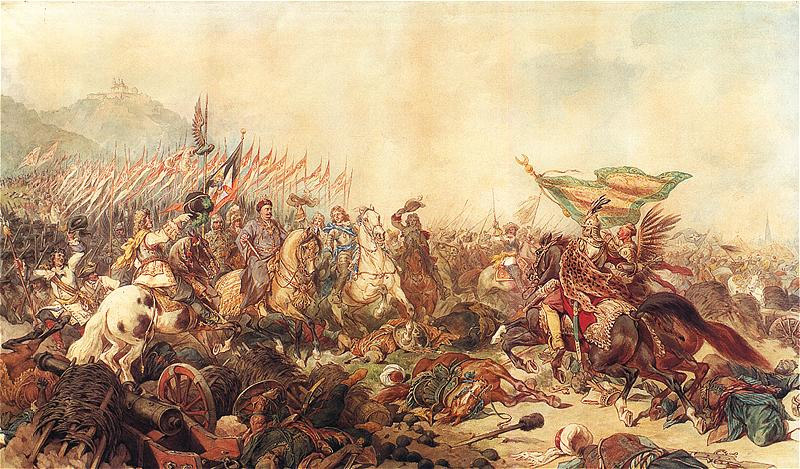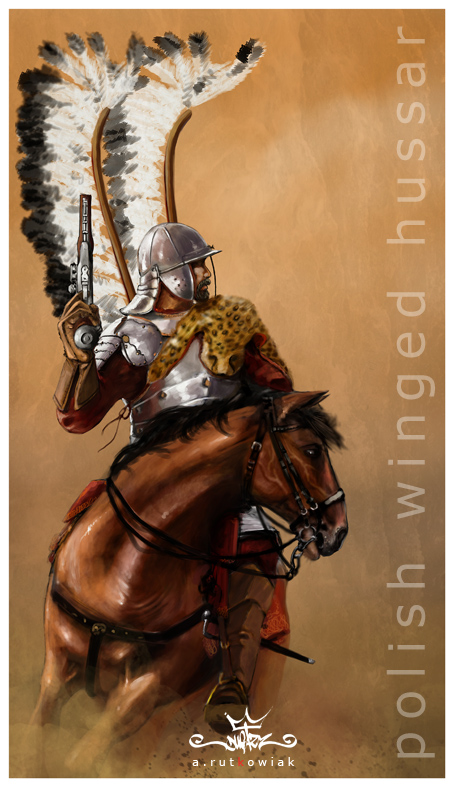It is hard to say from when started Polish-Serbian historical contacts but, relationship is continual and originates in time immemorial. What i can note is that history of Polish-Serbian contacts belong to most interesting chapters of Slavic and European reality.
This story is about Serbian influence on Polish military doctrine.
Did you know that famous Polish Winged Cavalry and Hussars represent one of crucial results of contacts between Polish and Serbian nobility, warrior class and people.
Then, read....
Story about Polish Hussars beggan with Turkish invasion on Slavic world, in moment when Turks reached western Balkan and south-eastern Europe, when they reached Serbian lands.
Serbian Hussars
dariocaballeros.blogspot.com/2009/04/serbian-hussars.html
Orsha battle; Polish-Serbian hussars can be seen in action circa AD 1514 in this very large 1530s painting from the Polish National Museum in Warsaw
Pictures and text that follow are from the work of Franchman Nicolas de Nicolay who described unknown Serbian Winged Rider- `Discours et histoire véritable des navigations, pérégrinations et voyages, faicts en la Turquie, Anvers, 1586`
original text >>>
here, among else, we can read: ``i was curious about that warrior, full in armour and feathers [for whom Nicolas de Nicolay thought that was Turkish deli-horseman] and, i asked about his faith... he said that he is Serbian and that he joined to the Turkish caravan only because he also travel to Istambul (Constantinople). He said that he only pretend to be nice to Turks but that he is Christian by his will and his soul and he said few prayers as a proof to confirm his identity- Simbol of faith, Mother of God and Our Father. Prayers were said in Greak and on his native Serbian langauge.``
in his book Nicolas de Nicolay contines: ``i asked warrior why he uses all those feathers on his equipment. To look more terribe to my enemies, to confuse them in battle- answered warrior. Warrior then said that by the tradition of his people, feathers could be used only by brave warriors who deserved that in real combat and who are known by their skils and virue. Featers are decoration exclusively for brave warriors. That`s what i was able to get as information from that warrior.``
pics are original work of Nicolas de Nicolay and represent unknown Serbian Winged Cavalier
Comparision of unknown Serbian warrior mantioned in above text with Polish Winged Hussar >>>
Very likely that the beginning of its existence Husarz owe to the Serbs. After the defeat at Kosovo in 1389, Serbs everywhere sought an opportunity to seek revenage on the Turks.
Jan Dlugosz enrolled in the year 1463, that the battle over the Sava fought Cohors Raczanorum (Raców branch - the Serbs). After the death of King Matthias Corvinus, the Serbs went to the Poland, to continue the struggle against the Turks after usarsku.
Encyclopedia Wirtualna Polska
encyklopedia.wp.pl/encid,1730632,name,racowie,haslo.html
to be continued
This story is about Serbian influence on Polish military doctrine.
Did you know that famous Polish Winged Cavalry and Hussars represent one of crucial results of contacts between Polish and Serbian nobility, warrior class and people.
Then, read....
Story about Polish Hussars beggan with Turkish invasion on Slavic world, in moment when Turks reached western Balkan and south-eastern Europe, when they reached Serbian lands.
Serbian Hussars
dariocaballeros.blogspot.com/2009/04/serbian-hussars.html
the very begining of Polish Hussaria belongs entirely to the Balkan Serbian warriors already known as hussars (for almost a hundred years prior to their coming to Poland).
They came to the Polish Kingdom, at the end of the 15th century, in search of military employment and probably somewhat of a easier life, and our Polish Kingdom did offer these noble refugees from the Turkish-Hungarian-Habsburg wars of the 15th century plenty of religious freedom and economic prosperity...
They came to the Polish Kingdom, at the end of the 15th century, in search of military employment and probably somewhat of a easier life, and our Polish Kingdom did offer these noble refugees from the Turkish-Hungarian-Habsburg wars of the 15th century plenty of religious freedom and economic prosperity...
Orsha battle; Polish-Serbian hussars can be seen in action circa AD 1514 in this very large 1530s painting from the Polish National Museum in Warsaw
Pictures and text that follow are from the work of Franchman Nicolas de Nicolay who described unknown Serbian Winged Rider- `Discours et histoire véritable des navigations, pérégrinations et voyages, faicts en la Turquie, Anvers, 1586`
original text >>>
here, among else, we can read: ``i was curious about that warrior, full in armour and feathers [for whom Nicolas de Nicolay thought that was Turkish deli-horseman] and, i asked about his faith... he said that he is Serbian and that he joined to the Turkish caravan only because he also travel to Istambul (Constantinople). He said that he only pretend to be nice to Turks but that he is Christian by his will and his soul and he said few prayers as a proof to confirm his identity- Simbol of faith, Mother of God and Our Father. Prayers were said in Greak and on his native Serbian langauge.``
in his book Nicolas de Nicolay contines: ``i asked warrior why he uses all those feathers on his equipment. To look more terribe to my enemies, to confuse them in battle- answered warrior. Warrior then said that by the tradition of his people, feathers could be used only by brave warriors who deserved that in real combat and who are known by their skils and virue. Featers are decoration exclusively for brave warriors. That`s what i was able to get as information from that warrior.``
pics are original work of Nicolas de Nicolay and represent unknown Serbian Winged Cavalier
Comparision of unknown Serbian warrior mantioned in above text with Polish Winged Hussar >>>
Very likely that the beginning of its existence Husarz owe to the Serbs. After the defeat at Kosovo in 1389, Serbs everywhere sought an opportunity to seek revenage on the Turks.
Jan Dlugosz enrolled in the year 1463, that the battle over the Sava fought Cohors Raczanorum (Raców branch - the Serbs). After the death of King Matthias Corvinus, the Serbs went to the Poland, to continue the struggle against the Turks after usarsku.
Encyclopedia Wirtualna Polska
encyklopedia.wp.pl/encid,1730632,name,racowie,haslo.html
racowie, lekka najemna jazda złożona z Serbów, znana na Węgrzech od XIV w.; w Polsce w końcu XV-pocz. XVI w. służyli w obronie potocznej.
to be continued
 PolishForums LIVE / Archives [3]
PolishForums LIVE / Archives [3]


